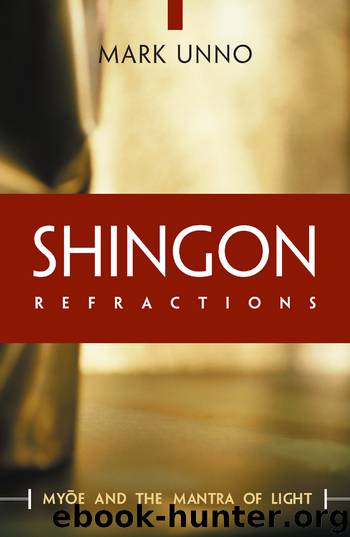Shingon Refractions by Mark Unno

Author:Mark Unno
Language: eng
Format: epub
Publisher: Wisdom Publications
SECOND FASCICLE
• The passage “The syllable ha arises following the syllable a”:
“Following the syllable a” means to become two, like giving birth to a child. It does not become three. To explain the meaning, this is to say that first the mind arises, and with this one comes to know it. The wisdom attained after the fundamental basis refers to before and after [ ... ] before and after the explanation of the meaning. When opening [ ... ] everything is a. This gradually becomes o.
• The passage “As [from the fact that] all dharmas are unborn with a as their basis”:
That all dharmas are unborn refers to what has been written in kana-syllabary (this is the Kanjinki). This stands apart from eternalism and nihilism. The thoughts of ordinary beings are based on the two attachments to self and to dharmas, and that [ ... ] of the actual body [ ... ] finally [ ... ] confused. If, with respect to person and dharmas, one awakens out of attachment to self and dharmas, then this is the awakening of the Buddha.
QUESTION: Previously, you stated that all syllables have a as their basis. What about this?
ANSWER: The head of all syllables is a. In the Shingon [school] the contemplation of the seed-syllable is an esteemed practice. The contemplation of the seed-syllable is good for those whose natures are of middling quality. In the Liqu jing, (Sutra on the Ultimate Meaning of Principle) there is the phrase, “the prajñā-pāramitā [transcendental wisdom] of the light of the various dharmas.” This refers to the illumination of emptiness of all dharmas. The practitioner is exhorted to contemplate this; the yoga practitioner must construct the mandala with Mañjuśrī and the other bodhisattvas in repose at the center. Even if Mañjuśri does not attain repose [during the practitioner’s contemplation], one must be in accord with the principle. If this is not achieved, then it will be as though one were dying even though there are no stricken foxes or badgers.59 This will not end as long as one fails to practice, and one will be born in a world where practice cannot be established, and one’s mind will float about [lost]. (If the illness of one’s practice in the buddha-dharma does not reach an end, then the deluded affect of the two attachments to person and dharmas will not die. Think very carefully on this.)
• The passage “The voice of ū signifies that the destruction of all dharmas cannot be realized”:
As for the syllable ū, in India this indicates denial, and ū is said [...] This is used as a word for denial. As for [the terms] “word-root” and “word-relation,” the part of a word that is the base is the “word-root.” [For example, the word in Sanskrit for] “knowledge” is jñāna; jña is the word-root, and na is the word-relation. Similarly, the word for “denial” is ū-plus-something.
• The passage “On top of the script for this syllable there is the marking for the anusvāra and the anunāsika.
Download
This site does not store any files on its server. We only index and link to content provided by other sites. Please contact the content providers to delete copyright contents if any and email us, we'll remove relevant links or contents immediately.
The Way of Zen by Alan W. Watts(5798)
Ego Is the Enemy by Ryan Holiday(3991)
The Art of Happiness by The Dalai Lama(3382)
The Book of Joy by Dalai Lama(3217)
Why Buddhism is True by Robert Wright(2826)
Shift into Freedom by Loch Kelly(2692)
Spark Joy by Marie Kondo(2675)
Happiness by Matthieu Ricard(2522)
A Monk's Guide to a Clean House and Mind by Shoukei Matsumoto(2404)
The Lost Art of Good Conversation by Sakyong Mipham(2125)
The Meaning of the Library by unknow(2067)
The Third Eye by T. Lobsang Rampa(1883)
The Unfettered Mind: Writings from a Zen Master to a Master Swordsman by Takuan Soho(1859)
Anthology by T J(1752)
Red Shambhala by Andrei Znamenski(1747)
The Diamond Cutter by Geshe Michael Roach(1671)
Thoughts Without A Thinker: Psychotherapy from a Buddhist Perspective by Epstein Mark(1591)
Advice Not Given by Mark Epstein(1521)
Twilight of Idols and Anti-Christ by Friedrich Nietzsche(1491)
